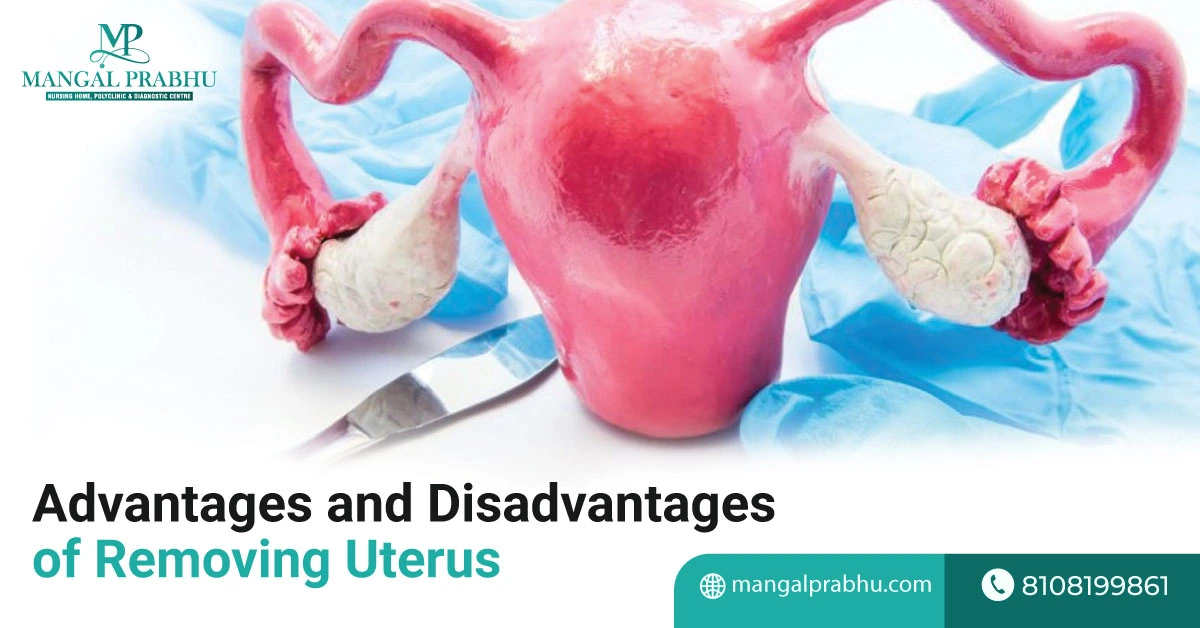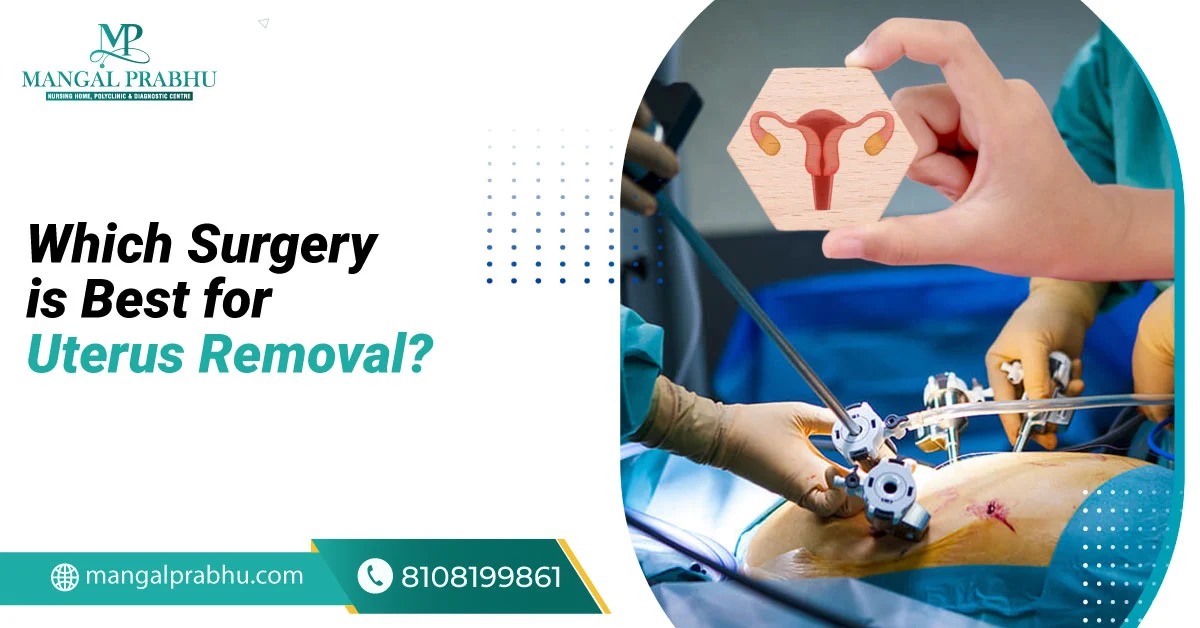
Advantages and Disadvantages of Removing Uterus
Hysterectomy or uterus removal is a major surgical procedure that’s performed in women with fibroids, uterine prolapse, cancer, and other reproductive issues. While the uterus removal surgery in Navi Mumbai can be a life-saving treatment for women, it comes with its share of drawbacks. Your gynecologist will discuss the advantages and disadvantages of removing the uterus to help you make an informed decision. Here’s what you should know.
Advantages of Removing the Uterus
1) Relief From Pain:
For women diagnosed with endometriosis, fibroids, and other uterine issues that cause heavy bleeding and significant pain during and in between the menstrual cycles, hysterectomy is the best possible treatment. It removes the source of these issues, improving your quality of life.
2) Prevent Recurring Fibroids:
Women with fibroids can have them removed while keeping the uterus intact. However, that comes with the risk of recurring fibroids. If you want permanent relief, hysterectomy is the most reliable option.
3) Reduced Risk of Uterine Cancer:
If you have a family history of uterine cancer, you may want to consider getting the uterus removed. That’s the only way to be assured that you won’t get uterine or endometrial cancer. In some cases, ovaries are also removed during the surgery, eliminating the risk of ovarian cancer.
Also Read: Which Surgery is Best for Uterus Removal?
Disadvantages of Removing the Uterus
i) Potential Hormonal Imbalances:
Uterus removal comes with significant hormonal changes, especially if the ovaries are removed. It induces immediate menopause in women, no matter how young they are. Menopause comes with hot flashes, mood swings, reduced bone density, and other symptoms that might be hard to cope with.
ii) Impact on Fertility:
The biggest drawback of hysterectomy is the loss of childbearing potential. Once you have had the surgery, you cannot become pregnant. This can result in a lifetime of regret for women of childbearing age.
iii) Possible Surgical Risks:
Like any major surgery, uterus removal requires an extensive hospital stay. Depending on where you get the surgery and the hospital’s protocol, you can expect to stay 1-3 days in the hospital post-surgery. Besides, it comes with the risk of surgical complications, like pulmonary embolism, hematoma, injury to nearby organs, and more.
Considerations Before Undergoing Surgery
A laparoscopic hysterectomy doctor in Navi Mumbai can perform a minimally invasive surgery, which involves a laparoscope that helps your surgeon remove the uterus without making a large incision on your abdomen. That said, it’s still advisable to consult a healthcare professional and discuss the recovery time and possible post-surgical complications before considering it.
Besides, you don’t necessarily need the uterus removal surgery. Alternatives like getting the fibroids removed (myomectomy), endometrial ablation, and medication can help relieve your symptoms. That said, the most viable treatment plan for you depends on your symptoms, their severity, and your fertility goals.
If you are past your childbearing age and are concerned about recurring fibroids, consider uterus removal. Talk to your gynecologist to figure out the best treatment option for your reproductive health issues. If you’ve decided on getting a hysterectomy, consider working with a gynecologist specializing in laparoscopic hysterectomy to minimize the risk of complications and ensure a faster recovery.

Which Surgery is Best for Uterus Removal?
Hysterectomy is the surgical removal of the woman’s uterus. It’s often considered a last resort for medical issues like endometriosis, uterine fibroids, polyps, cancer, enlarged uterus, uterine prolapse, and uterine rupture. The surgery, however, comes with potential risks. A woman can’t get pregnant without a uterus.
Moreover, if your ovaries were removed during hysterectomy, you will enter menopause immediately. Choose the best hysterectomy surgeon in Navi Mumbai and understand the different surgical methods used for hysterectomy.
Types of Uterus Removal Surgeries
1) Abdominal Hysterectomy
An open abdominal surgery is common for uterine fibroids, hyperplasia, and certain types of cancer. The surgeon makes a 5-7-inch cut either vertically or horizontally above your pubic bone and removes the uterus. If required, the doctor might perform an immediate oophorectomy (ovaries removal) and salpingectomy (fallopian tube removal).
Pros:
- It gives your surgeon a direct access to the uterus and a clear view of the surrounding organs.
- It’s effective for certain conditions where less-invasive procedures might not work.
- The doctor can easily detect any abnormality in your ovaries, fallopian tubes, cervix, and other reproductive parts during the surgery
Cons:
- Longer hospital stay
- Slow recovery
- Higher risk of post-surgical complications
- Scarring
2) Vaginal Hysterectomy
Vaginal hysterectomy is the least invasive and most preferred option for women undergoing hysterectomy. The surgeon makes a small incision on the top of your vagina and uses special instruments to detach the uterus and remove it through the vagina.
Pros:
- It’s performed on an outpatient basis, which means the patient can go home within 24 hours after the procedure.
- Fewer complications
- Quick recovery
- No scarring
Cons:
- It can lead to incomplete removal of the uterine tissues
- Infection around the incision
3) Laparoscopic Hysterectomy
A laparoscope is a thin tube with light and a camera attached to its end. A uterus removal surgery in Navi Mumbai is mainly performed with a laparoscope. The surgeon administers local anesthesia and makes small incisions on your abdomen (about half an inch). They insert a laparoscope into one of the holes, cut the uterus into small pieces, and remove it through the vagina.
Pros:
- Faster healing and quick recovery
- Fewer complications
- Shorter hospital stay
- Lower risk of infection
Cons:
- Not effective for patients with large uterine fibroids, hyperplasia, malignant tumors, and advanced endometriosis.
4) Robotic-assisted Hysterectomy
Robot-assisted hysterectomy is similar to a laparoscopic procedure. The only difference is that a robotic arm is used to perform a hysterectomy.
Pros:
- Offer greater precision
- Short hospital stay
- Fast recovery
Cons:
- Not effective for all cases
Factors to Consider When Choosing a Surgery
A vaginal hysterectomy is the best option for women who want to recover faster and get back to work within 2-3 weeks. There are fewer to no complications, and you can go home the same day after surgery. Laparoscopic hysterectomy is the second-best option. If vaginal hysterectomy is not possible due to an enlarged uterus or fibroids, or other serious issues, your doctor will advise laparoscopic hysterectomy.
The surgeon will consider the patient’s age, health status, uterus size, and previous scars when advising the hysterectomy surgery method.
